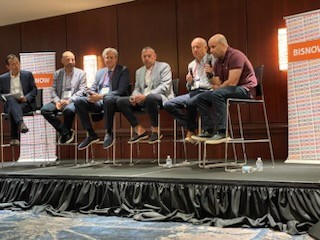It’s a thrill for the OCOLO team to be here with our CEO, Tony Rossabi , at the RBC Capital Markets 2024 Global Communications Infrastructure Conference, hosted by lead communications infrastructure sector analyst Jonathan Atkin and his team.
The first day of the two-day event was packed with one- and two-on-one fireside chats or group panel discussions hosted or moderated by Jonathan or members of his research team at RBC Capital Markets. Many industry leaders representing different parts of the data center sector shared their perspectives on key themes of the day. We’ll share some snippets from the morning panel: Investing in a Time of Unprecedented Growth and Capital Demand, moderated by Nicholas Stevenson, RBC Capital Markets, in this LinkedIn dispatch.
Panelists:
Anubhav Raj – Chief Financial Officer, Aligned Data Centers
Andrea Drasites – Senior Managing Director, Blackstone
Jared Day – President & Chief Financial Officer, Compass Datacenters
Matthew A’Hearn – Managing Partner, IPI Partners
Will Innes – Head of Investments, NTT Global Data Centers
Theme 1: How the AI theme has played out over the last 5 years and how it will play out going forward now that we’re moving into true use cases
- Andrea Drasites, Blackstone – It’s still early innings in the game, so no one yet knows the plays to come or the ultimate winners. We’re still bullish on the overall tailwinds, but increasingly focused on de-risking in terms of capital, balance sheet, lease structures, etc. We’ll definitely see resets along the way that will take fortitude on the part of investors because nothing is a straight line.
- Will Innes, NTT Global Data Centers – We see it not in innings but as a long game. ChatGPT changed everything in 2022. Since then, there’s been a frenzy across industries that caused over-excitement in markets, with everyone thinking all the sites and power will be snatched up. There will be twists and turns and ultimate winners and losers, but if you’re in infrastructure, the rising tide will lift all boats.
- Anubhav Raj, Aligned Data Centers – We’ll see both a continuation of the past few years of trends and the game will keep on changing. Cloud trends are not ending or changing, for example. From here, power constraints are the biggest factor driving trends. Where are the investments? Where do we want to focus? Do we want to go to middle of nowhere for power? I would call it batting practice: the real game hasn’t even started yet. But I’m excited for how it will play out. The systemic issues with utilities don’t have overnight solutions and the scale of campuses creates a competitive moat if you’ve already reached certain size/scale.
- Jared Day, Compass – It’s early innings and clearly a land grab. We all have our specific areas of focus. The stats on QTS Data Centers are amazing and make me shudder, but Compass Datacenters is not trying to be that. We’re disciplined and have debates all the time on how big we want to be. We’re trying to do the same thing over and over again and get really good at it. Sometimes, that’s at the expense of growth.
Theme 2: Will the divergence of public and private capital valuations continue?
- Andrea Drasites, Blackstone – We saw a similar disconnect in the zero cost of capital years 2021-22. A lot of buckets of capital then were short-term, closed-end capital. Now, public markets, due to a variety of reasons, including the euphoria of AI, think of the data center industry differently and put a premium on companies with robust development pipelines, which will mean more participants. We still feel like private markets are a more flexible way to invest in the space. Private investors can can go big and lean into our history of investment in equipment and capital deployment expertise without being beholden to quarterly reporting and public shareholder scrutiny. It’s a more efficient way to operate.
- Matt A’Hearn, IPI Partners – The biggest difference is what you can do with your balance sheet. Using REITs vs. ABS and using loan to value basis vs loan to cost basis financing. It hasn’t synced up yet on public/private basis. We don’t have a solution for that yet.
- Anubhav Raj, Aligned Data Centers – There are significant differences in the capitalization and balance sheets of private vs public. We’ll continue to see big changes where it will take time to change public market understanding and perception. It’s not as black and white and there’s a lot of appetite for the asset class. And there are alternative capital sources that are new or just being conceived today, so there’s an education process.
Theme 3: Where are you finding new opportunities to add value to clients?
- Matt A’Hearn, IPI Partners – We’re working with clients to help customize their designs, as well as on new liquid cooling solutions. We’re trying to be more flexible and engage clients earlier on solutions on AI-enabled designs.
- Anubhav Raj, Aligned Data Centers – We’re more focused on partnerships with local constituents, utilities and customers. We all understand the challenges and the need for collaboration.
- Jared Day, Compass – We’re about collaboration and flexibility and upgradeability and the ability to meet the evolving demands of customers. Even if we can’t forecast how they’ll evolve over 5-10 years, we’re doing our best to navigate that transition in a relatively non-destructive and cost-effective way.
- Will Innes, NTT Global Data Centers – You can’t take the same piece of dirt and the same site and show it to 5-6 people. You need to make more effort in investing in the site first, in proving out the argument for the value of the site and its attributes more.
- Andrea Drasites, Blackstone – I haven’t met anyone who isn’t looking at the data center space in past few years. Everyone has had to up their game.

